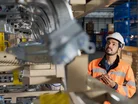GTK: IoT, Sustainability & Touchscreen Tech in Manufacturing

After a turbulent few years, 2024 has brought a shift in attitudes, with many manufacturers taking a more positive view on the year ahead. Paul Dearman, Head of Business Development at custom cable assemblies manufacturer GTK, agrees with the positive outlook for 2024. “We’re finally starting to see the dust settle on a long period mired by Brexit red tape and supply chain breakdowns as a result of COVID-19.
Innovation in manufacturing processes
Automation is a transformative digital process that continues to go from strength to strength.
“In terms of progress in automation, it feels like we’re seeing it grow daily rather than yearly. It can come in many forms and be utilised from small tasks to entire end-to-end processes,” says Paul. “One of the key ways automation has transformed manufacturing is in the way it has helped expedite the early stages of product development, enabling manufacturers to bring a product to market more quickly than ever.”
Paul points to tools like Graphisoft’s Archicad, which frees up time and resources in production teams by automating the creation of early stage designs. This is a small application of automation that can reap enormous rewards in productivity, efficiency and ultimately contribute to the bottom line.
As Paul puts it: “Firms who aren’t automating extensively can expect to get left behind by more efficient manufacturers.”
Widespread IoT integration powered by reliable connectivity solutions
Just like automation, the internet of things (IoT) is not a new technology. But as we progress, its application is becoming more widespread across commercial and residential spaces.
“We’re seeing more smart homes than ever before, and we’re moving past the initial appeal of controlling lights and heating remotely,” says Paul. “Now, businesses across various sectors are implementing smart sound systems, smart security and much more.”
In terms of manufacturers’ use of IoT-enabled technology, it will “revolutionise the way we manage our supply chain,” according to Paul. “In 2024, OEMs can monitor the movement of materials, parts and products and proactively deal with any delays or disruptions.”
With this increased application of the IoT comes the demand for more reliable connectivity solutions.
“These technologies have necessitated a call for reliable data and power transmission in non-standard settings. OEMs require cable assemblies and connectors that are robust enough to meet those needs in more difficult environments,” Paul says. “OEMs should therefore be aware of the increased demand for purpose-built solutions and consider how their existing infrastructure can adapt to support that.”
Manufacturers prioritise sustainability in supply chains
A recent report from Make UK and Barclays has highlighted how important it is for manufacturers to have strategic environmental, social and corporate governance (ESG) commitments. It found that 77% of manufacturers are receiving ESG requests from their customers, while a further 74% are building ESG requirements into their procurement processes.
“With net zero on the horizon, businesses across the country are interrogating their operating practices in more depth,” adds Paul. “Sustainability is becoming a more important concern than ever, as stakeholders at every level become increasingly concerned about the provenance of their electronics.
“As a zero-waste-to-landfill business, GTK is well-prepared for this increased demand for sustainability. Not only do we consider it in our materials and processes, but we also use sustainable practices in our factories and offices. We report details of our UK and Romanian facilities’ materials usage, waste and recycling, and 95% of our lighting uses energy-efficient LED bulbs,” he says.
So, what can manufacturers in the early stages of their sustainability journey do?
“Offering your customers alternative or sustainably sourced materials could be the difference between winning their business and failing to do so,” says Paul. “Be transparent, too. More OEMs than ever are building structured requirements for sustainability in their supplier tenders, so you can’t hide beyond smoke and mirrors.”
In the longer term, businesses must address their green credentials internally and create policies and processes that limit their impact on the environment, offset it or contribute positively to it.
“Considering the wants and needs of end users is essential for manufacturers looking to move forward,” concludes Paul. “All of these trends come from the desire for more personalised solutions, more responsibility from suppliers and the use of technology in a way that’s familiar and makes their lives easier.”
******
Make sure you check out the latest edition of Manufacturing Digital and also sign up to our global conference series - Procurement & Supply Chain 2024 & Sustainability LIVE 2024
******
Manufacturing Digital is a BizClik brand.
- The University Manufacturing Circuit Boards from LeavesSustainability & ESG
- Schneider Electric's Commitment to Sustainable ManufacturingSustainability & ESG
- Lenovo & Saudi Alat Building Green Manufacturing FacilitySustainability & ESG
- Nissan Brings Biodiversity to the Factory through RewildingSustainability & ESG

